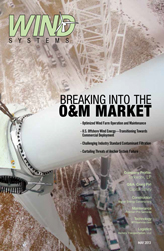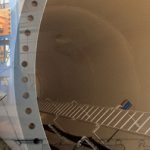It is no surprise that a common goal amongst the wind industry’s participants is to lower the total cost of ownership associated with developing wind farms without sacrificing on HSE. One way that companies can achieve this goal is by consistently seeking ways to adopt best business practices and by thinking outside of the box.
Auge Industrial Fasteners has a commitment to safety and innovation. One way in which it demonstrates this is through the integration of R&D and customer collaboration, or concurrent engineering. Figure
To help illustrate this point, this article focuses on the significance of removing entrapped hydrogen from steel and how Auge, in collaboration with a customer, sought an innovative approach to minimize the risk of hydrogen embrittlement without cutting back on quality or safety.
In seismic regions around the world, hardened high-tensile strength anchoring systems are required (See Figure 1.), which must be at a minimum 1040 Mpa (Reference ISO 898-1).
To make such materials comply with this value of resistance, its hardness is usually located above 35 HRC, as these are thermally treated by means of quenching and tempering. The original equipment manufacturers of wind turbines have established as a requirement the avoidance of the natural phenomenon of corrosion by means of hot dip galvanization.
The process of hot-dip galvanizing typically consists of three steps per the American Galvanizers Association, including surface preparation, galvanizing, and inspection. During the surface preparation step, the steel material is introduced to acidic solutions like sulfuric acid or hydrochloric acid as a method for the removal of surface impurities and oxides.
The problem arises when coating a high-strength hardened alloy material by means of the hot-dip galvanization process. During this first step, there is a high probability of a phenomenon known as “Environmental Hydrogen Embrittlement” occurring because of the material coming in contact with the acid medium. SideBar
Environmental Hydrogen Embrittlement results from hydrogen being absorbed by solid metals. When hydrogen diffuses along the grain boundaries the hydrogen atoms are absorbed into the metal lattice and diffused through the grains, tending to gather at inclusions or other lattice defects.
Disassociated hydrogen ions take up very little space, but when the hydrogen ions combine to form hydrogen molecules (H2) they take up tens of thousands of times more space.
This applies stress on a granular level and may cause cracks to form, thus causing the part to fail when additional outside stress is applied during use. Also, this usually results in a loss of ductility or load carrying capacity, which may cause catastrophic brittle failures at applied stresses well below the yield strength. Failures occurring in service are serious and may be very costly.
Figure 2 and Figure 3 show hydrogen embrittlement introduced during the galvanizing process.
For hydrogen to impose damage to steel, it must be in the atomic form. Being that hydrogen has the smallest atomic mass, it can enter the molecular structure of the steel. This is not true when two hydrogen atoms combine to form a stable H2 molecule. Hydrogen in the molecular form is too dense to penetrate the steel structure.
Because hydrogen is exceptionally mobile, it quickly penetrates into any recently formed cracks, lesions, or material surface discontinuities, and creates high stress areas within the steel structure.
When embrittlement failures do occur, they often drastically increase the costs and lead times associated with the development of a project.
In order to prevent this phenomenon, it is very common to use alternative methods of cleaning such as sand blasting or air blasting instead of using acid solutions. Also, it may be recommended to use post-backing for dehydrogenization.
To ensure risk reduction, Auge Industrial Fasteners has developed an alternative cleaning method consisting of an alkaline de-scaling process. The results are in full compliance with ASTM A153 and EN 10684 (thickness, adhesion test, etc.). Upon completion of laboratory testing and customer approval, Auge now applies hot-dip galvanized anchoring systems safely, through a process free of acidic solutions. This process achieves the reduction of cost and lead time by reducing the need for baking the steel.
This alkaline cleansing process, known as Auge Rhino™, is one example of how Auge can create secure and innovative solutions that benefit the customer’s bottom line, security, and industry. Since 1965, Auge Industrial Fasteners has been recognized as a leading manufacturer and distributor of a wide variety of commercial, specialty, and exotic alloy fasteners, and specialty machine parts. Auge’s 150,000 sq. ft. state-of-the-art manufacturing facility near Mexico City has a large capacity to produce specialty fasteners tailored to the customer’s unique specifications and drawings. The plant is a fully integrated turnkey operation. Every process is performed under the same roof, from the stocking of the raw steel (foreign and domestic), to the in-house heat treatment, to the coating/plating (if applicable).







































